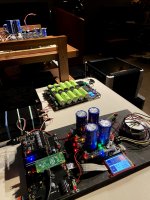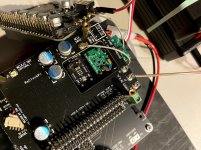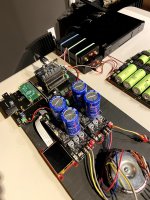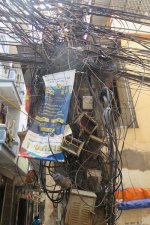Thanks Ian!
What is the "Pure 3000F ultra capacitor power supply"? I don't see anything similar in your GB offering.
Otherwise it sounds like this is what I'm looking at:
StationPi
RPi Z/W [5v]
FifoPi Q3 [3.3v]
ReClockPi [3.3v]
TransportPi [3.3v]
LifePo4 Mk3 x1 [5v][3.3v][3.3v][3.3v][]
UcConditioner x4 [5v][3.3v][3.3v][3.3v]
Am I right?
Is ConditionerPi recommended over a 5v UcConditioner if using the LifePo4 supply?
Thank you! It will be interesting to see where this setup lands me in performance compared to something like a Lumin U1 or dCS Network Bridge.
Cheers.
What is the "Pure 3000F ultra capacitor power supply"? I don't see anything similar in your GB offering.
Otherwise it sounds like this is what I'm looking at:
StationPi
RPi Z/W [5v]
FifoPi Q3 [3.3v]
ReClockPi [3.3v]
TransportPi [3.3v]
LifePo4 Mk3 x1 [5v][3.3v][3.3v][3.3v][]
UcConditioner x4 [5v][3.3v][3.3v][3.3v]
Am I right?
Is ConditionerPi recommended over a 5v UcConditioner if using the LifePo4 supply?
Thank you! It will be interesting to see where this setup lands me in performance compared to something like a Lumin U1 or dCS Network Bridge.
Cheers.
1) what is the difference between FifoPi Q3 and ReClockPi?
ReClockPi can improve FifoPi signal quality more. But it doesn't work without a FifoPi.
2) does replacing 2x LinearPi with LiFePo4 Mk3 bring any advantages to SQ? Assuming I’ll be adding UcConditioners for all rails
For power supply quality
Pure 3000F ultra capacitor power supply > LifePO4 + UcConditioner > LinearPi + UcConditioner > LifePO4 >LinearPi
3) Are there any other components that would raise the performance? I see clocks, isolators and some other components mentioned.
Besides XO clocks, power supplies are the most significant things to the sound quality.
4) the system needs to be WiFi capable (I don’t have Ethernet on the stereo side of my room). Is the setup sufficiently isolated from any WiFi related Rpi noise? Can it support a Pi Zero W?
RPi Z/W is very good for low noise EMI wifi connection. Please don't use Pi3 with wifi.
Ian
Last edited:
@absolutk
Pure 3000F ultra capacitor power supply is what I'm working, so not yet be available.
All others are correct.
Regards,
Ian
Pure 3000F ultra capacitor power supply is what I'm working, so not yet be available.
All others are correct.
Regards,
Ian
Trying to get the most out of TWTMC clocks for FifoPi system (1)
Just to get round to start testing the TWTMC clocks
My setups
Clock section:
1. TWTMC DIRXO 22.5792MHz
2. LifePO4 13.2V pure battery power supply
Fifo Section:
1. FifoPi Q3
2. TWTMC-STS- SX sine to square convertor
3. ReClockPi
4. HDMIpi II
Source section:
1. StationPi Pro
2. ReceiverPi MKII
3. RaspberryPi Z/W
Power supply section:
1. LinearPi Dual 5V+3.3V
2. UcConditioner 5V
3. UcConditioner 3.3V
All power supplies are controlled under the same ON/OFF signal by connecting isolated control cables in between
DAC section:
Topping D90 AK4499 DAC with HDMI I2S/DSD input
D90 setups:
1. Change setting 8 to REV
2. Chang setting 9 to DSDR/DATA
3. Also have to enable FifoPi’s 16 to 32 lossless converter function by setting SW2 to On because D90 doesn’t support true 16 bit format.
To make things easier, I use a signal TWTMC DIRXO setup just for test for now.
Ian
Just to get round to start testing the TWTMC clocks
My setups
Clock section:
1. TWTMC DIRXO 22.5792MHz
2. LifePO4 13.2V pure battery power supply
Fifo Section:
1. FifoPi Q3
2. TWTMC-STS- SX sine to square convertor
3. ReClockPi
4. HDMIpi II
Source section:
1. StationPi Pro
2. ReceiverPi MKII
3. RaspberryPi Z/W
Power supply section:
1. LinearPi Dual 5V+3.3V
2. UcConditioner 5V
3. UcConditioner 3.3V
All power supplies are controlled under the same ON/OFF signal by connecting isolated control cables in between
DAC section:
Topping D90 AK4499 DAC with HDMI I2S/DSD input
D90 setups:
1. Change setting 8 to REV
2. Chang setting 9 to DSDR/DATA
3. Also have to enable FifoPi’s 16 to 32 lossless converter function by setting SW2 to On because D90 doesn’t support true 16 bit format.
To make things easier, I use a signal TWTMC DIRXO setup just for test for now.
Ian
Attachments
Pure 3000F ultra capacitor power supply is what I'm working, so not yet be available.
Ian
Great news!
And another question, can you somehow describe the difference in sound from using Pulsar or Andrea? How much is it heard in your setup?
I am interested in whether it is possible to listen to a setup with clocks Pulsar after listening with clocks Andrea? 🙂
On a composition with different frequencies, it is not difficult to compare.
WTMC vs Pulsar
This will be interesting. Let it run 7/24 for a few days before drawing any conclusions.
This will be interesting. Let it run 7/24 for a few days before drawing any conclusions.
@Ian
All the PSUs are good but i am not clear with this list which in your view is the best?
Pure 3000F ultra capacitor power supply > LifePO4 + UcConditioner > LinearPi + UcConditioner > LifePO4 >LinearPi
What audio software do you run on the RaspberryPi Z/W out of interest please?
Many of us use Ropieee to create a Roon endpoint but Ropieee does not support the RaspberryPi Z/W yet
All the PSUs are good but i am not clear with this list which in your view is the best?
Pure 3000F ultra capacitor power supply > LifePO4 + UcConditioner > LinearPi + UcConditioner > LifePO4 >LinearPi
What audio software do you run on the RaspberryPi Z/W out of interest please?
Many of us use Ropieee to create a Roon endpoint but Ropieee does not support the RaspberryPi Z/W yet
@ SimonJ
I use Volumio play music from both local and DLNA server (Foobar2000 DLNA server is so far the best)
Also Tidal MQA re-direct to Volumio by cell phone.
How to Play TIDAL /Local MQA music on a Raspberry Pi with Volumio - YouTube
You don't have to use RPi Z/W, RPi 4 is also good and much better than RPi 3 (bad wifi EMI).
Ian
I use Volumio play music from both local and DLNA server (Foobar2000 DLNA server is so far the best)
Also Tidal MQA re-direct to Volumio by cell phone.
How to Play TIDAL /Local MQA music on a Raspberry Pi with Volumio - YouTube
You don't have to use RPi Z/W, RPi 4 is also good and much better than RPi 3 (bad wifi EMI).
Ian
@Ian - thanks and I use a Pi3 today with Ropieee/Roon/Tidal and works great but use it wired not wifi
Which end of this list is the best PSU please?
Pure 3000F ultra capacitor power supply > LifePO4 + UcConditioner > LinearPi + UcConditioner > LifePO4 >LinearPi
Which end of this list is the best PSU please?
Pure 3000F ultra capacitor power supply > LifePO4 + UcConditioner > LinearPi + UcConditioner > LifePO4 >LinearPi
@ SimonJ
Pure 3000F ultra capacitor power supply could be the best power supply so far in the real world 🙂.
Ian
Pure 3000F ultra capacitor power supply could be the best power supply so far in the real world 🙂.
Ian
You don't have to use RPi Z/W, RPi 4 is also good and much better than RPi 3 (bad wifi EMI).
Hello,
I recently especially searched for a RPI 3 because i have been told that because it does not have all the features the RPI 4 that i wont be using .
Because i read it is a good idea to keep the Roon nucleus at some distance from your audio gear and because the raspberry can also have some negative side effects i think that introducing wifi in my DDDAC should be avoided.
Maybe i will try to introduce some extra shielding around the Raspberry
Greetings, Eduard
P.s found a nice cap at Mouser see the power supply thread
Hello,
I recently especially searched for a RPI 3 because i have been told that because it does not have all the features the RPI 4 that i wont be using .
Because i read it is a good idea to keep the Roon nucleus at some distance from your audio gear and because the raspberry can also have some negative side effects i think that introducing wifi in my DDDAC should be avoided.
Maybe i will try to introduce some extra shielding around the Raspberry
Greetings, Eduard
P.s found a nice cap at Mouser see the power supply thread
@ SimonJ
Pure 3000F ultra capacitor power supply could be the best power supply so far in the real world 🙂.
Ian
Thanks
Look forward to hearing about it 🙂
Hello Ian,
I will kind of copy the '' set up '' of Simon and he was the one who told me it would be better to get the older raspberry.
I will invest a bit more in the power supplies AND i will reduce the power supply cables as much as possible by '' installing '' the stationpi with the 5 volt UcCondtioner and 3 3,3 volt UcHybrid boards a bit above the lifepo4 board using a safe and secure way instead of having a board that needs to get bigger every few months because parts '' needed '' to be added.
I really think that once you are kind of forced to put things to far apart the benefits will disappear.
In the past you would start on one end with the power supply and then move to the other end where the sound is being made. But many people do pimp the sound part and will have to add one( if they are lucky) that in order to give real benefits will need a supply voltage that is not available so there needs to be an extra circuit added outside the already big wooden mounting board.
My idea is that a lot of energy that Ian, Doede and Andrea spend on the optimum print layout is wasted once you end up covering everything in something that looks like Vietnamese powerline distribution.
Greetings, eduard
I will kind of copy the '' set up '' of Simon and he was the one who told me it would be better to get the older raspberry.
I will invest a bit more in the power supplies AND i will reduce the power supply cables as much as possible by '' installing '' the stationpi with the 5 volt UcCondtioner and 3 3,3 volt UcHybrid boards a bit above the lifepo4 board using a safe and secure way instead of having a board that needs to get bigger every few months because parts '' needed '' to be added.
I really think that once you are kind of forced to put things to far apart the benefits will disappear.
In the past you would start on one end with the power supply and then move to the other end where the sound is being made. But many people do pimp the sound part and will have to add one( if they are lucky) that in order to give real benefits will need a supply voltage that is not available so there needs to be an extra circuit added outside the already big wooden mounting board.
My idea is that a lot of energy that Ian, Doede and Andrea spend on the optimum print layout is wasted once you end up covering everything in something that looks like Vietnamese powerline distribution.
Greetings, eduard
Attachments
@Edward - I recommended the Pi3 for a Roon endpoint setup that is wired. I dont use wifi
No need to have a more powerful Pi in this case, which takes more power and not needed
If wifi then the Pi 4 is better so you are clear
No need to have a more powerful Pi in this case, which takes more power and not needed
If wifi then the Pi 4 is better so you are clear
Hello Simon,
That is what i did understood so happily this idea is solid as a rock.
Greetings, eduard
That is what i did understood so happily this idea is solid as a rock.
Greetings, eduard
Great news!
And another question, can you somehow describe the difference in sound from using Pulsar or Andrea? How much is it heard in your setup?
I am interested in whether it is possible to listen to a setup with clocks Pulsar after listening with clocks Andrea? 🙂
On a composition with different frequencies, it is not difficult to compare.
This will be interesting. Let it run 7/24 for a few days before drawing any conclusions.
Hi Ian,
Yes, please this. I'm still targeting "Pulsar" clocks for the portable side, but it will require a MOQ of 5 so any impressions compared to the WTMC would be great. It would reduce the risks.
I hope to have the WTMC implemented end of summer, so that will give me a reference point to justify a portable "Pulsar" clock setup. I was hoping to keep it low profile, but with the RCP in the mix adding a "Pulsar" should be no problem.
I'm so glad that uber expensive NDK is not DIP14. That just hit my radar this month. Otherwise it would be one NDK versus five "Pulsars".
Last edited:
Pure 3000F ultra capacitor power supply > LifePO4 + UcConditioner > LinearPi + UcConditioner > LifePO4 >LinearPi
I think Ian was doing this when considering priority of best:
I think Ian was doing this when considering priority of best:
- Pure 3000F ultra capacitor power supply
- LifePO4 + UcConditioner
- LinearPi + UcConditioner
- LifePO4
- LinearPi
- LiFePO4 + Pure 3000F ultra capacitor power supply
- LinearPi + Pure 3000F ultra capacitor power supply
- LifePO4 + UcConditioner
- LinearPi + UcConditioner
- LifePO4
- LinearPi
- LiFePO4 + Pure 3000F ultra capacitor power supply
- LifePO4 + UcConditioner
- LinearPi + Pure 3000F ultra capacitor power supply
- LinearPi + UcConditioner
- LifePO4
- LinearPi
Last edited:
That's pure 😀
Only 3000F ultra capacitor applies to the circuit when it's on. It will be charged only at off time.
For FifoPi clean side, it runs an hour or longer before voltage drop from 3.3V to 3V. The quality is nothing compared.
It also has a continuous mode for XOs, runs 7/24 never stopped.
No any ground connections, pure isolated.
Ian
Only 3000F ultra capacitor applies to the circuit when it's on. It will be charged only at off time.
For FifoPi clean side, it runs an hour or longer before voltage drop from 3.3V to 3V. The quality is nothing compared.
It also has a continuous mode for XOs, runs 7/24 never stopped.
No any ground connections, pure isolated.
Ian
In Ian We Trust. Good luck with the 3000F. 3000F + WTMC should= God-tier amazing.
BTW, since I'm back on RPi; I'm likely going to go with AudioLinux realtime kernel w/ RPI4 8GB. PiCorePlayer also has CPU isolation, but they are never going to have a realtime kernel. I need a 4GB Squeezelite buffer along with CPU isolation and realtime, etc.
I don't know if I can get it working with the Q3 yet, but hopefully that's the plan.
I was planning AudioLinux on PC, but AudioLinux on RPi should be a nice alternative.
BTW, since I'm back on RPi; I'm likely going to go with AudioLinux realtime kernel w/ RPI4 8GB. PiCorePlayer also has CPU isolation, but they are never going to have a realtime kernel. I need a 4GB Squeezelite buffer along with CPU isolation and realtime, etc.
I don't know if I can get it working with the Q3 yet, but hopefully that's the plan.
I was planning AudioLinux on PC, but AudioLinux on RPi should be a nice alternative.
Last edited:
@ SimonJ
Pure 3000F ultra capacitor power supply could be the best power supply so far in the real world 🙂.
Ian
That's pure 😀
Only 3000F ultra capacitor applies to the circuit when it's on. It will be charged only at off time.
For FifoPi clean side, it runs an hour or longer before voltage drop from 3.3V to 3V. The quality is nothing compared.
It also has a continuous mode for XOs, runs 7/24 never stopped.
No any ground connections, pure isolated.
Ian
Look forward to hear more regarding this Ian as it develops 😀
- Home
- Source & Line
- Digital Line Level
- Asynchronous I2S FIFO project, an ultimate weapon to fight the jitter



